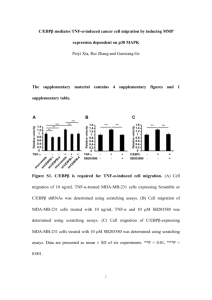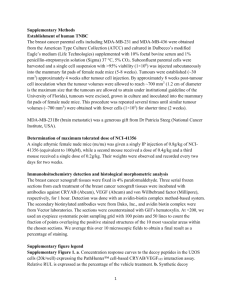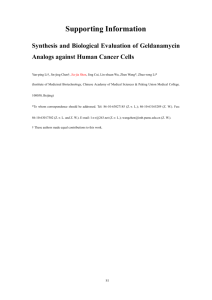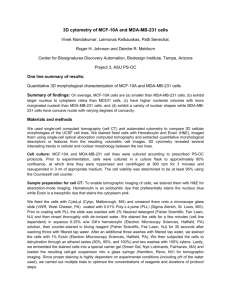Supplementary Information (docx 26K)
advertisement
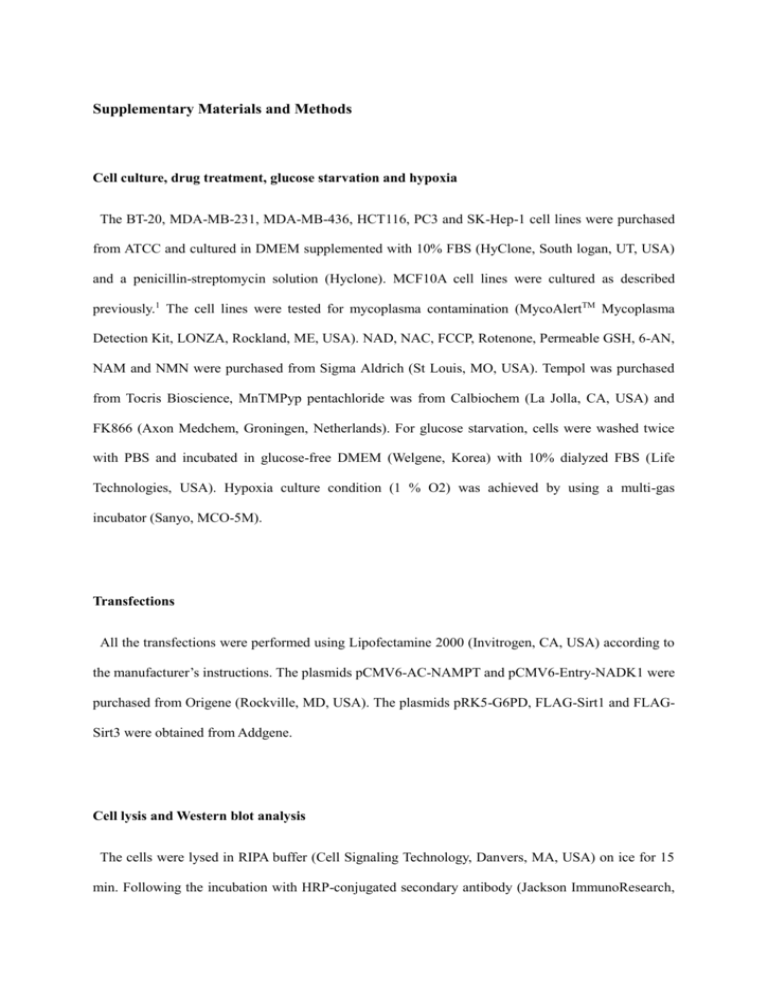
Supplementary Materials and Methods Cell culture, drug treatment, glucose starvation and hypoxia The BT-20, MDA-MB-231, MDA-MB-436, HCT116, PC3 and SK-Hep-1 cell lines were purchased from ATCC and cultured in DMEM supplemented with 10% FBS (HyClone, South logan, UT, USA) and a penicillin-streptomycin solution (Hyclone). MCF10A cell lines were cultured as described previously.1 The cell lines were tested for mycoplasma contamination (MycoAlertTM Mycoplasma Detection Kit, LONZA, Rockland, ME, USA). NAD, NAC, FCCP, Rotenone, Permeable GSH, 6-AN, NAM and NMN were purchased from Sigma Aldrich (St Louis, MO, USA). Tempol was purchased from Tocris Bioscience, MnTMPyp pentachloride was from Calbiochem (La Jolla, CA, USA) and FK866 (Axon Medchem, Groningen, Netherlands). For glucose starvation, cells were washed twice with PBS and incubated in glucose-free DMEM (Welgene, Korea) with 10% dialyzed FBS (Life Technologies, USA). Hypoxia culture condition (1 % O2) was achieved by using a multi-gas incubator (Sanyo, MCO-5M). Transfections All the transfections were performed using Lipofectamine 2000 (Invitrogen, CA, USA) according to the manufacturer’s instructions. The plasmids pCMV6-AC-NAMPT and pCMV6-Entry-NADK1 were purchased from Origene (Rockville, MD, USA). The plasmids pRK5-G6PD, FLAG-Sirt1 and FLAGSirt3 were obtained from Addgene. Cell lysis and Western blot analysis The cells were lysed in RIPA buffer (Cell Signaling Technology, Danvers, MA, USA) on ice for 15 min. Following the incubation with HRP-conjugated secondary antibody (Jackson ImmunoResearch, PA, USA), detection was performed using the SuperSignal West Pico chemiluminescent substrate (Pierce, Rockford, IL, USA). A primary antibody against NAMPT was from Bethyl Laboratories (Montgomery, TX, USA). The anti-β-actin antibody and anti-NADK antibody were from Santa Cruz Biotechnology (CA, USA), and the NAPRT antibody was from Proteintech Group (Chicago, IL, USA). Primary antibodies against G6PD and cleaved capase-3 were from Cell Signaling Technology. The anti-ATG7 antibody and anti-cleaved caspase-3 antibody were from Cell Signaling Technology. A primary antibody against Bnip-3 was from Novus. The NAPRT antibody was from Proteintech Group (Chicago, IL, USA). Stable gene knockdown using lentiviral gene delivery Scrambled sequence and NAMPT-knockdown recombinant lentiviral particles were purchased from Sigma-Aldrich. MDA-MB-231 cells were transduced with lentiviral particles at a multiplicity of infection (MOI) of 1 in a 24-well plate. Three days after transduction, the cells were cultured in media containing 2 µg/ml puromycin, and stable cell lines were established. Gene silencing with siRNAs Negative control siRNA, On-TARGETplus SMARTpool human NAMPT siRNA (Cat. No. M004581-01-0005), On-TARGETplus SMARTpool human G6PD siRNA (Cat. No. L008181-020005), On-TARGETplus SMARTpool human NADK siRNA (Cat. No. L006318-00-0005) and OnTARGETplus SMARTpool human ATG7 siRNA (Cat. No. L-020112-00-0005) were purchased from Dharmacon. siRNA duplexes were added at a final concentration of 100 nM. Trypan blue assay After 24 h of glucose deprivation, the cells were collected by treating with trypsin. To measure cell viability, the cells stained with trypan blue were counted using a hemocytometer. Flow Cytometry The cells were plated at a density of 4×105 cells in 60-mm dishes. After glucose deprivation for 12 h, the cells were harvested by trypsinization and the DNA was stained with propodium iodide (BD PharmigenTM) according to the manufacturer’s instructions. Cell death was determined by flow cytometry (BD Biosciences, USA). ATP assay After 18 h of glucose deprivation, the cells were harvested and analyzed using a CellTiter-Glo(R) Luminescent Cell Viability assay (Promega, Madison, WI, USA) according to the manufacturer’s instructions. Glycogen/glucose assay After 6 h of glucose deprivation, the cells were harvested and analyzed using a Glycogen Colorimetric/fluorometric assay kit (Biovision, Milpitas, CA, USA) according to the manufacturer’s instructions. Immunohistochemistry Xenograft tumors were excised and fixed in formalin, and embedded in paraffin. 5 mm tissue slices were stained for Ki-67 (1:200). 5 mm tissue slices were stained with Ki-67 antibody (1:200) to visualize the proliferating cells. The region of cell death was assessed by TUNEL assay kit (Roche) according to the manufacturer’s instruction. Slices were counterstained with hematoxylin and eosin. Stained slides were scanned at 10X on Olympus. Slide Virtual Microscopy. Images of whole tumor sections were captured and analyzed with Image J software. . SUPPLEMENTARY FIGURE LEGEND Fig S1. Glucose deprivation induced cell death via apoptosis in NAMPT knockdown cells. (A) MDA-MB-231_N.C cells and MDA-MB-231_shNAMPT cells were incubated under glucose deprivation in the presence or absence of FK866 or NAD+. Cell death was assessed by flow cytometry using PI staining. (B) MDA-MB-231 cells were treated with non-targeting or NAMPT siRNAs for 48 h. After glucose starvation for additional 24 h, apoptosis was determined by cleaved caspase-3 levels in western blot analysis. (C) BT-20 and MDA-MB-231 cells were subjected to glucose starvation for 24 h and apoptosis was assessed by cleaved caspase-3 levels in western blot analysis. Fig. S2. Reduced tumor size is due to cell death in the xenograft model. Immunohistochemical staining of xenograft tumor tissues arisen from injection of MDA-MB-231_N.C or MDA-MB231_shNAMPT cells (n=8). Tumor tissues were embedded in paraffin and sectioned (5 mm thick). (A) The sections were stained with Ki-67 antibody to visualize the proliferating cells. The region of cell death was assessed by TUNEL assay kit as described in Materials and Methods. (B) Slides were scanned at 10X on Olympus .Slide Virtual Microscopy. Images of whole tumor sections were captured. (B) Areas of whole tissues and necrotic region in the center were measured by Image J software. The ratio of necrotic region to whole tissue was quantified. The bars represent the mean ± SD (n = 8). *P < 0.05 by t-test. Fig. S3. ATP reduction by glucose deprivation is not related to NAMPT expression levels. ATP levels were measured after glucose starvation for 18 h in each MDA-MB-231 shNAMPT clone. NAMPT expression level of each clone was determined by western blot analysis (right panel). The bars represent the mean ± SD (n = 9). *P < 0.05 by t-test. Fig. S4. Role of NAMPT might not be relevant in hypoxic conditions. (A, B) MDA-MB-231_N.C and MDA-MB-231_shNAMPT cells were subjected to hypoxia (1% O2) for 24 h. Accompanying hypoxia, various treatments, including glucose starvation, NAD+ addition and FK866 treatment, were challenged. ROS levels were measured and resultant cell death was assessed by trypan blue assay. (C) Hypoxic conditions were validated by BNIP3 protein expression using western blotting. The bars represent the mean ± SD (n = 9). *P < 0.05 by t-test. Fig. S5. NAMPT protects MDA-MB-231 cells from cell death induced by mitochondrial ROS. (A, B) MDA-MB-231_N.C and MDA-MB-231_shNAMPT cells were challenged with FCCP (50 µM) or Rotenone (50 µM) for 24 h and cell death was assessed by trypan blue assay. (C) MDA-MB231_N.C and MDA-MB-231_shNAMPT cells were treated with FK866 for 24 h or NAD+ for 12 h. Following FCCP treatment for additional 6 h, mitochondrial ROS was measured with mitoSOX. The bars represent the mean ± SD (n = 9). *P < 0.05 by t-test. Fig. S6. The protective role of NAMPT is also relevant in different types of cancer cell lines. SK_Hep-1 (A), PC3 (B) and HCT116 (C) cells were treated with non-targeting or NAMPT siRNAs for 48 h. Following FK866 treatment for 24 h or NAD+ addition for 12 h, ROS levels or cell death were determined. NAMPT knockdown in each cell line was confirmed by western blotting. The bars represent the mean ± SD (n = 9). *P < 0.05 by t-test. Fig. S7. Sirt1 or Sirt3 might not be involved in NADPH regulation by NAMPT. MDA-MB-231 cells were treated with non-targeting, NAMPT, Sirt1 and Sirt3 siRNAs, respectively. After 48 h of transfection, cells were exposed to glucose deprivation for 6 h and NADPH measurement was conducted The bars represent the mean ± SD (n = 9). *P < 0.05 by t-test. Fig. S8. Influx of NAD+ increases NADPH level. MDA-MB-231 cells were incubated with NAD+ (1 mM) for up to 48 h. NADPH level was measured at indicated time points. The bars represent the mean ± SD (n = 9). *P < 0.05 by t-test. Fig. S9. MDA-MB-231 cells are more sensitive to FK866 under glucose starved-conditions than MCF10A cells. MCF10A and MDA-MB-231 cells were treated with FK866 for 24 h and subjected to glucose starvation. Duration of glucose starvation is dependent on the type of assays. For NADPH (A) and GSH measurement (B), glucose starvation was for 6h. Glucose starvation was for 3 h and 12 h to measure GSSG/GSH ratio (C) and ROS (D), respectively. The bars represent the mean ± SD (n = 9). *P < 0.05 by t-test. Fig. S10. GSH protects MDA-MB-231 cells from cell death induced by glucose deprivation. MDA-MB-231_N.C and MDA-MB-231_shNAMPT cells were incubated under glucose deprivation with or without permeable GSH for 18 h. Cell death was determined by the trypan blue assay. The bars represent the mean ± SD (n = 9). *P < 0.05 by t-test; n.s., not significant.. Fig. S11. NADK and G6PD are required for NADPH maintenance and ROS regulation under glucose deprivation. Non-targeting, G6PD or NADK siRNAs were transfected in MDA-MB-231 cells and subjected to glucose starvation. In the presence or absence of NMN, ROS levels were determined. The bars represent the mean ± SD (n = 9). *P < 0.05 by t-test; n.s., not significant.. Fig. S12. Glucose is supplied by autophagy under glucose starvation. (A, B) MDA-MB-231 cells were transfected with non-targeting or ATG7 siRNAs. After 48 h of transfection, cells were incubated under glucose starvation for additional 6 h. Glycogen and glucose contents were determined. ATG7 knockdown was confirmed by western blot analysis. The bars represent the mean ± SD (n = 9). *P < 0.05 by t-test. Fig. S13. Long-term treatment of FK866 is cytotoxic. MDA-MB-231 cells were treated with FK866 (20 nM) for 5 up to 5 days and cell death was assessed by trypan blue assay at indicated time points. Culture media was changed every two day. The bars represent the mean ± SD (n = 9). *P < 0.05 by t-test. Fig. S14. Glucose starvation-induced cell death is due to PPP inhibition, not glycolysis blockage. MDA-MB-231 cells were subjected to glucose deprivation in the presence or absence of 2DG. (A) After 6 h of starvation, NADPH levels were assessed. (B) After 12 h of starvation, ROS levels were determined. (C) Cell death was measured after starvation for 24 h. The bars represent the mean ± SD (n = 9). *P < 0.05 by t-test; n.s., not significant.. Fig. S15. NAPART1 and NADK expressions in different types of breast cancer cell lines were assessed by western blot analysis using whole-cell lysates. Supplementary Material Reference 1 Schafer ZT, Grassian AR, Song L, Jiang Z, Gerhart-Hines Z, Irie HY et al. Antioxidant and oncogene rescue of metabolic defects caused by loss of matrix attachment. Nature 2009; 461: 109-113.
